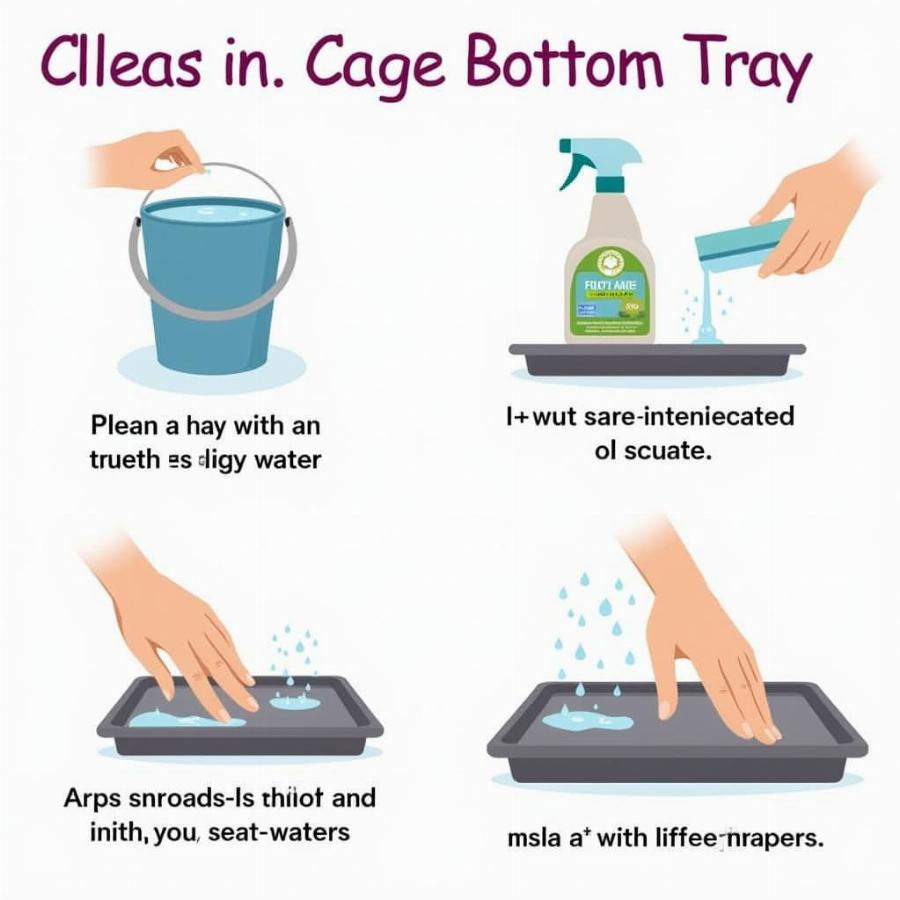A bottom tray for a dog cage, sometimes called a dog cage pan or dog crate tray, is a crucial component of any dog owner’s toolkit. It not only keeps your furry friend’s living space clean and hygienic but also contributes to their overall comfort and well-being. Whether you’re a seasoned dog owner or just starting out, understanding the ins and outs of bottom trays for dog cages is essential for responsible pet ownership. This guide will delve into everything you need to know, from choosing the right material to cleaning tips and tricks.
Choosing the Right Bottom Tray for Your Dog Cage
Choosing the right tray can seem daunting with so many options available. Consider your dog’s size, breed, and habits. A larger dog will require a more durable and larger tray, while a smaller dog may do well with a standard-sized option. Puppies, especially those still being house-trained, might benefit from a tray with higher sides to prevent spills. Material is also a key factor.
Material Matters: Durability and Cleanliness
The material of your dog cage bottom tray plays a vital role in its longevity and ease of cleaning. Common materials include plastic, metal, and composite. Plastic trays are lightweight, affordable, and generally easy to clean. Metal trays are more durable and resistant to chewing, making them a good option for powerful chewers. Composite trays offer a balance of durability and ease of cleaning.
What about absorbency? Some owners prefer absorbent materials, while others find them harder to clean. Think about your dog’s habits and your personal cleaning preferences.
Sizing Up the Situation: Finding the Perfect Fit
Measuring your dog’s crate is crucial for finding a tray that fits snugly. A properly fitting tray prevents accidents from spilling over the edges and makes cleaning much easier. Make sure the tray doesn’t slide around inside the crate, as this can be uncomfortable for your dog. Some manufacturers offer trays designed specifically for their crates, ensuring a perfect fit.
Why is a Snug Fit So Important?
A snug fit ensures that your dog’s paws stay dry and prevents them from stepping in their own waste. This contributes to a cleaner, healthier environment for your pet and makes your life easier as an owner.
Cleaning and Maintenance: Keeping Things Fresh
Regular cleaning of the dog cage bottom tray is essential for hygiene. Remove solid waste daily and wash the tray with soap and water at least once a week. For tougher stains, consider using a pet-safe disinfectant. Always rinse thoroughly after cleaning to remove any residue that could be harmful to your dog.
How Often Should You Clean Your Dog’s Bottom Tray?
Daily spot cleaning and a thorough weekly wash are generally recommended. However, you might need to clean more frequently if your dog has accidents or is prone to making a mess.
 Cleaning a Dog Cage Bottom Tray: Soap, Water, and Disinfectant
Cleaning a Dog Cage Bottom Tray: Soap, Water, and Disinfectant
Beyond the Basics: Additional Considerations
Think about adding a liner to your dog’s bottom tray for easier cleanup. Newspaper, puppy pads, or reusable liners can all be effective. Just make sure your dog isn’t tempted to chew and ingest the liner material. Also, consider raising the bottom tray slightly to improve ventilation and prevent your dog from lying directly on a cold or damp surface.
Elevated Dog Cage Trays: Pros and Cons
Elevated dog cage trays can offer benefits like improved ventilation and comfort, especially in warmer climates. However, they can also be more difficult to clean and may not be suitable for all dogs, particularly puppies or senior dogs who might have difficulty climbing in and out.
Conclusion: A Clean Tray, a Happy Dog
A bottom tray is a small but significant investment in your dog’s health and happiness. By choosing the right tray, maintaining it properly, and addressing your dog’s specific needs, you can create a comfortable and hygienic living space for your furry friend. Remember, a clean tray is essential for a happy, healthy dog.
FAQs
-
What’s the best material for a dog cage bottom tray? The best material depends on your dog’s individual needs. Plastic is affordable and easy to clean, metal is durable, and composite offers a balance of both.
-
How often should I replace my dog’s bottom tray? Replace the tray when it becomes cracked, warped, or excessively stained.
-
Can I use newspaper as a liner? Yes, but make sure your dog doesn’t eat it.
-
What if my dog chews on the tray? Consider a metal tray or a chew-resistant plastic option.
-
Are elevated trays good for all dogs? Elevated trays may not be suitable for puppies or senior dogs.
-
How can I prevent my dog’s tray from sliding around? Look for trays specifically designed for your dog’s crate or use non-slip mats.
-
What’s the difference between a dog cage tray and a dog cage plastic tray? A dog cage tray is a general term, while a dog cage plastic tray specifies the material. You can find more information about plastic trays at our dog cage plastic tray article.
More helpful resources
- Understanding Dog Crate Sizes
- House Training Your Puppy
- Choosing the Right Dog Crate
Beaut Dogs is your ultimate guide to all things related to dog care. We offer valuable insights into breed characteristics, care tips, training advice, and product recommendations to help you nurture a happy and healthy canine companion. For personalized support and expert advice, feel free to reach out to us at [email protected] (Email address). Visit Beaut Dogs today to explore a world of information for dog lovers!